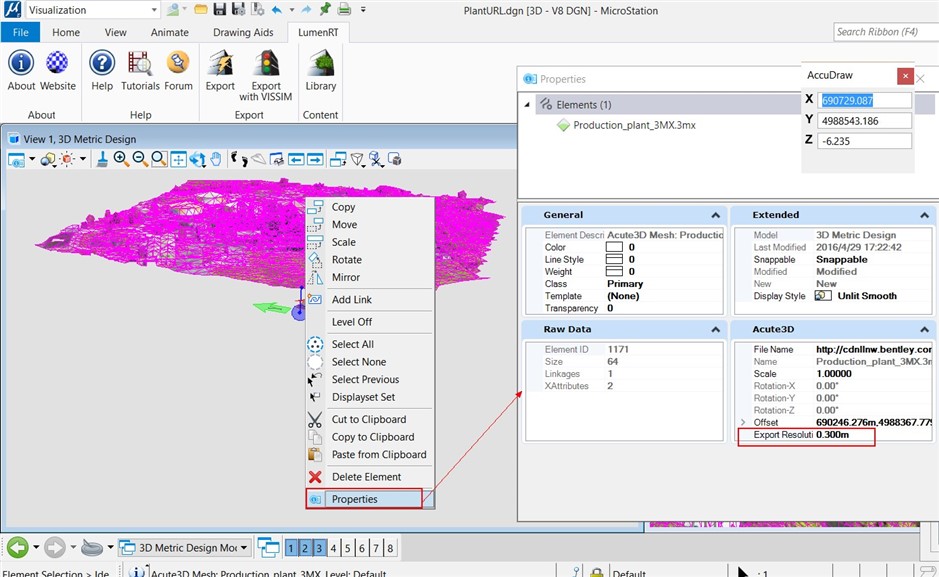

Projects with extreme overlapping instances can control the method Lumen uses with the project setting Software Ray Tracing Mode. By default, Lumen traces against each mesh's distance field for the first two meters for accuracy, and the merged Global Distance Field for the rest of each ray. The renderer merges Mesh Distance Fields into a Global Distance Field to accelerate tracing. This tracing representation is supported on any hardware supporting Shader Model 5 (SM5), and only requires that Generate Mesh Distance FIelds be enabled in the Project Settings. Lumen uses Software Ray Tracing against Signed Distance Fields by default. Software Ray Tracing is the only performant option in scenes with many overlapping instances, while Hardware Ray Tracing is the only way to achieve high quality mirror reflections on surfaces. It requires supported video cards and systems to operate. Hardware Ray Tracing supports a larger range of geometry types for high quality by tracing against triangles and to evaluate lighting at the ray hit instead of the lower quality Surface Cache. Software Ray Tracing uses Mesh Distance Fields to operate on the widest range of hardware and platforms but is limited in the types of geometry, materials, and workflows it can effectively use. Lumen provides two methods of ray tracing the scene: Software Ray Tracing and Hardware Ray Tracing. You can perform this type of comparison by disabling Screen Traces from the Level Viewport's Show > Lumen menu and removing the check next to Screen Traces. Screen Traces help resolve the mismatch that can happen between the triangle scene and Lumen Scene. When disabling Screen Traces for global illumination and reflections, it is possible to see only the Lumen Scene produced by Software Ray Tracing. The example scene below uses Screen Traces first before falling back to other, more costly tracing options. Setting a large Indirect Lighting Scale on a light will cause view-dependent global illumination, as Screen Traces cannot support it correctly.

The disadvantage in using screen traces is that they greatly limit controls for art direction, which would only apply to indirect lighting, like lighting properties for Indirect Lighting Scale or Emissive Boost. Screen tracing supports any geometry type and is useful for covering up mismatches between the Lumen Scene and triangle scene.

Lumen features trace rays against the screen first (called Screen Tracing or Screen Space Tracing), before using a more reliable method if no hit is found, or the ray passes behind a surface. Importing an entire room, which includes furniture, in a single mesh is not expected to work with Lumen. Only meshes with simple interiors can be supported - walls, floors, and ceilings should all be separate meshes. Adjusting the number of cards is useful for more complex interiors or single meshes with irregular shapes.Īreas that don't have Surface Cache coverage are colored pink in the Surface Cache View Mode of the Level Editor.
#LUMENRT REVIT PLUG IN OFFLINE#
These capture positions (called Cards) are generated offline for each mesh.Ĭards can be visualized with the console command r. 1.īy default, Lumen only places 12 Cards on a mesh, but you can increase that amount by setting Max Lumen Mesh Cards in the Build Settings of the Static Mesh Editor. Lumen captures the material properties for each mesh from multiple angles. It is used to quickly look up lighting at ray hit points in the scene. Lumen generates an automatic parameterization of the nearby scene's surface called Surface Cache.
#LUMENRT REVIT PLUG IN 1080P#
The engine's Epic scalability level produces around 8 milliseconds (ms) on next-generation consoles for global illumination and reflections at 1080p internal resolution, relying on Temporal Super Resolution to output at quality approaching native 4K. Lumen's secondary focus is on clean indoor lighting at 30 FPS on next-generation consoles. The engine's High scalability level contains settings for Lumen targeting 60 FPS. Lumen's Global Illumination and Reflections primary shipping target is to support large, open worlds running at 60 frames per second (FPS) on next-generation consoles.


 0 kommentar(er)
0 kommentar(er)
